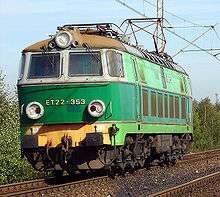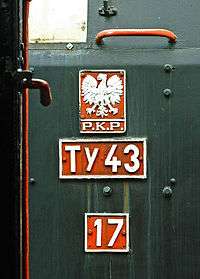PKP classification system
PKP classification system (Polish locomotive designation) is a system of assigning letters and numbers to series and individual locomotives used by the PKP - Polish national railroad operator.
The system was introduced for steam stock by the Ministry of Railways on 3 November 1922, shortly after Poland regained her independence (1918), when the Polish railroads inherited a variety of German, Austrian and Russian steam locomotives, each with its own type convention.[1] It was put into use in 1923–1926 years. The adopted solution allows telling the locomotive type (passenger/freight/mixed), wheel arrangement, origin and some other information from the type designation. After World War II a similar system was also adapted for diesel and electric locomotives.
Electric and diesel locomotives

In case of electric and diesel locomotives, and multiple units, a designation consists of two capital letter and two digits, without a space between letters and digits. The first letter E or S indicates a kind of traction (electric or diesel), the second letter indicates a locomotive purpose. Digits mark subsequent classes, and their ranges also carry an additional information on construction features. Some railcar classes have three digits.
First letter
- E - electric locomotive (Polish: elektryczna)
- S - diesel locomotive (Polish: spalinowa)
Second letter
Locomotives
Electric multiple units
Diesel railcars and multiple units
Numbers
Electric locomotives
- 01-14 - four axles, Bo-Bo, direct current, 3 kV
- 15-19 - four axles, Bo-Bo, alternating current
- 20-34 - six axles, Co-Co, direct current, 3 kV
- 35-39 - six axles, Co-Co, alternating current
- 40-49 - other types
In the case of electric and diesel locomotives consisting of two cars, the letters A and B were added after the serial number for each car but the number is still the same for both the cars, or after important modernisation (look for EU07A).
Electric multiple units
- 51–64 – three-car set, 3 kV DC
- 65–69 – three-car set, AC
- 70–74 – four-car set, 3 kV DC
- 75–79 – four-car set, AC
- 80–89 – single electric car, any voltage or type of current
- 90–93 – two car sets, 800 V DC
- 94–99 – other
Every car in a multiple unit is further designated by its own suffix:
- s – (silnikowy) motor car (with or without a driver's cab)
- d – (doczepny) trailer car without a driver's cab
- r – (rozrządczy) trailer car with a driver's cab
If there are more than one car of a given designation in a unit, they are further identified with letter 'a' or 'b'. For example, a typical 3-car EMU class EN57 consists of the following cars:
- ra (trailer car with a driver's cab)
- s (motor car, in this case without a driver's cab)
- rb (trailer car with a driver's cab)
Another 3-car EMU, class EW58, consists of the following cars:
- sa (motor car, in this case with a driver's cab)
- d (trailer car without a driver's cab)
- sb (motor car, in this case with a driver's cab)
Example of a single car's designation: EN57-830ra.
Diesel locomotives
- 01–09 – mechanical transmission, no multiple-unit control
- 10–14 – mechanical transmission, multiple-unit control
- 15–24 – hydraulic transmission, no multiple-unit control
- 25–29 – hydraulic transmission, multiple-unit control
- 30–39 – electric transmission, no multiple-unit control
- 40–49 – electric transmission, multiple-unit control
Diesel railcars and multiple units
- 51–59 – mechanical transmission, no multiple-unit control
- 60–69 – mechanical transmission, multiple-unit control
- 70–79 – hydraulic or hydro-mechanical transmission, no multiple-unit control
- 80–89 – hydraulic transmission, multiple-unit control
- 90–94 – electric transmission, no multiple-unit control
- 95–99 – electric transmission, multiple-unit control
Steam locomotives
Designations of standard gauge PKP steam locomotives consist of two letters (or three letters in case of tank locomotives) and a number written directly behind the letters. Designations of narrow gauge locomotives follow other rules.
First letter
The upper case letter means:
Last letter
Last letter (lower case) indicates the wheel arrangement, in increasing order of the number of driving axles.
- a - one driving axle, any number of unpowered axles
- b - 0-4-0
- c - 2-4-0 or 0-4-2
- d - 4-4-0 or 0-4-4
- e - 2-4-2
- f - 4-4-2 or 2-4-4
- g - two driving axles, more than three unpowered axles,
- h - 0-6-0
- i - 2-6-0 or 0-6-2
- k - 4-6-0 or 0-6-4
- l - 2-6-2
- m - 4-6-2
- n - 2-6-4
- o - three driving axles, more than three unpowered axles
- p - 0-8-0
- r - 2-8-0 or 0-8-2
- s - 4-8-0 or 0-8-4
- t - 2-8-2
- u - four driving axles, more than two unpowered axles
- w - 0-10-0
- y - 2-10-0
- z - five driving axles, more than one unpowered axle
Middle letter
In the case of tank engines, the letters designating the type of engine and the wheel arrangement are separated by a K (upper case). Thus TKt48 is a 2-8-2T tank locomotive of Polish design introduced in 1948.
Number
- 1-10 - German or Prussian origin steam engine[1]
- 11-19 - Austrian origin steam engine[1]
- 20-99 - Polish-ordered steam engine, number stood for the last two digits of the year in which the type was approved for production[1]
- 100 - different atypical stock, acquired after 1945, including former private and industry locomotives[2]
- 101-199 - Other foreign steam engine, acquired by PKP between 1918 and 1939 (including German land railways other, than Prussian)
- 201-299 - Other foreign production steam engine, acquired by PKP after 1945[1]
Serial numbers
Following the letters and numbers described above, the serial number of each individual locomotive is stated. This consists of several digits, separated from the type designation characters by a dash.
Tenders
First number
- First number of tender classification described water capacity in cubic meters made even upwards.[1]
Letter
- Letter described the number of axles, i.e.:[1]
- B - two axles
- C - three axles
- D - four axles
Second number
- This referred to the year of construction, so number 23 means the construction was approved in 1923. Numbers 1 to 10 meant Prussian or German origin, 11 to 19 - Austrian origin, above 101 - other foreign origin.[1]
An example
A tender numbered 22D23 can carry up to 22 m3 of water, has four axles, and its construction was approved in 1923.
See also
- Terczyński, Paweł (2003), Atlas parowozów, Poznań, ISBN 83-901902-8-1, p. 30-31 (in Polish)
- Terczyński, Paweł (2003), Atlas parowozów, Poznań, ISBN 83-901902-8-1, p. 95 (in Polish)
